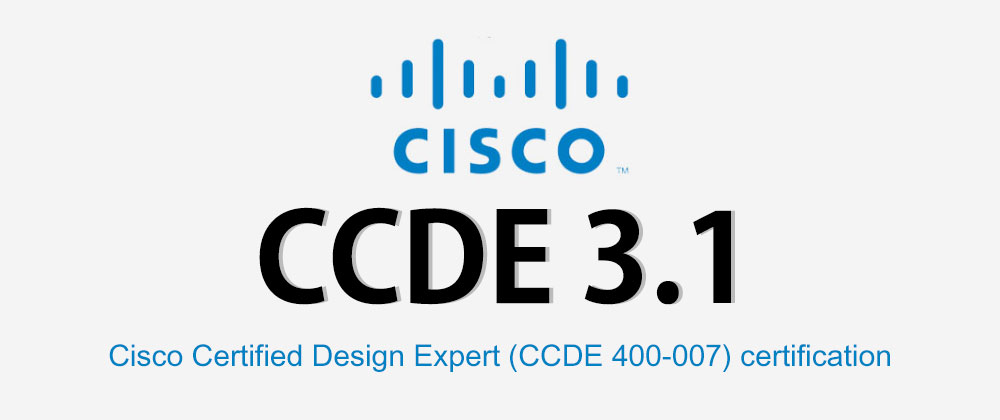
Earning your Cisco Certified Design Expert (CCDE) certification in 2025 is a major milestone — one that distinguishes you as a true network architecture strategist. The Cisco 400-007 CCDE exam validates your ability to translate complex business requirements into technical design decisions that scale, secure, and perform.
If you’re planning your study path, start smart: use Leads4Pass to access verified and updated 400-007 practice questions that align with the 2025 CCDE blueprint. Their materials are known for accurate, scenario-based content that simulates the real exam environment — the closest experience you can get before the actual test.
This ultimate guide will walk you through everything that matters — exam value, latest blueprint topics, realistic preparation strategy, career outlook, and even a reserved space for free practice questions and answers.
What Is the Cisco CCDE Certification?
The Cisco Certified Design Expert (CCDE) represents Cisco’s highest-level certification in network design and architecture. Unlike CCIE, which focuses on implementation and troubleshooting, CCDE assesses strategic design thinking, focusing on making high-level architectural decisions that align with organizational goals.
A CCDE-certified professional can:
- Analyze business and technical requirements.
- Design scalable, secure, and resilient network architectures.
- Evaluate the impact of design decisions on operations, automation, and governance.
- Communicate effectively with both executives and technical teams.
In 2025, the CCDE program continues to emphasize intent-based networking, automation, multi-cloud connectivity, and network assurance frameworks — the cornerstones of modern infrastructure design.
Why CCDE Matters More Than Ever in 2025
The world of networking has evolved far beyond physical routers and switches. Today, successful enterprises depend on automated, policy-driven, and secure architectures that support dynamic business needs. The CCDE proves you have the expertise to design those environments intelligently.
Key reasons why CCDE remains invaluable:
Long-Term Relevance: Design skills remain future-proof even as technologies change.
Strategic Credibility: CCDEs influence business outcomes through technology decisions.
Career Mobility: CCDEs transition naturally into roles like Enterprise Architect, Principal Consultant, or Infrastructure Strategist.
High Compensation: Average annual salaries range between $165,000 – $230,000, depending on specialization and region.
Cisco 400-007 CCDE Exam Overview (2025 Update)
The 400-007 exam assesses whether you can design technical solutions that balance business intent, risk, scalability, and lifecycle management.
| Exam Code | 400-007 CCDE |
|---|---|
| Exam Duration | 120 minutes |
| Exam Format | Multiple-choice and scenario-based design analysis |
| Delivery | Pearson VUE (online or at test centers) |
| Language | English |
| Cost | Approximately $450 USD |
| Validity | 3 years |
| Next Step | Eligible for the CCDE Practical Exam |
The written exam validates your conceptual understanding of network design principles, while the practical exam challenges you to create end-to-end architectures in real-world scenarios.
CCDE 400-007 Exam Topics and Focus Areas (Updated 2025 — Official v3.1)
Cisco updated the CCDE Unified Exam Topics (v3.1) to ensure alignment with evolving enterprise and service provider environments. The exam now emphasizes infrastructure design, automation, security, and network assurance as integrated elements of architecture.
| Domain | Weight | Core Topics (Official CCDE v3.1) |
|---|---|---|
| 1. Business Strategy Design | 15% | Impact on network design using project methodologies (e.g., Waterfall/Agile), business continuity and sustainability (e.g., RPO, ROI, CAPEX/OPEX, risk/reward), environmental sustainability, AI/ML business needs (data sovereignty, security, assurance, integrity, storage/traffic impacts, auto-scalability, cost/ROI, governance) |
| 2. Control, Data, Management Plane, and Operational Design | 25% | End-to-end IP traffic flow in feature-rich environments, data/control/management plane technologies, centralized/decentralized/hybrid control planes, automation/orchestration (APIs, model-driven management, controller-based tech, CI/CD evolution), software-defined architectures (SD-WAN, overlay/underlay, fabric), visibility/observability/assurance, user/application experience |
| 3. Network Design | 30% | Resilient, scalable, secure modular networks (traditional/SD architectures) considering technical/operational/application/business constraints, implementation/migration/transformation plans, automation goals; AI network use cases (machine learning, large language models, pattern recognition) |
| 4. Service Design | 15% | Resilient, scalable, secure modular designs supporting IP applications (voice/video/backups/replication/IoT/storage) based on constraints; cloud/hybrid solutions for business ops (regulatory compliance, data governance/sovereignty, service placement, SaaS/PaaS/IaaS, cloud connectivity like direct connect/MPLS/WAN, security, AI/ML) |
| 5. Security Design | 15% | Network security integration: segmentation, access control, visibility/observability/assurance, policy enforcement, CIA triad, regulatory compliance; AI impacts on security policy (IP/PII/proprietary info, quality/credibility, external AI services) |
The CCDE v3.1 blueprint ensures that candidates go beyond static network designs, empowering them to craft intelligent, self-adaptive architectures fueled by AI/ML-driven automation, observability, and cloud-native security policies—perfectly aligned with modern enterprise agility and sustainability goals.
How to Build a Winning CCDE Study Plan (2025)
To succeed in CCDE, you must think beyond configurations. It’s about design reasoning, business justification, and lifecycle alignment.
1. Learn the “Why,” Not Just the “How”
The CCDE measures decision-making ability, not command recall. Focus on understanding why certain architectures are chosen over others — think of scalability, manageability, and operational simplicity.
2. Review Cisco Validated Designs (CVDs)
Study CVDs across domains like Enterprise Campus, Data Center, and SD-WAN. These real-world architectures illustrate Cisco’s best-practice frameworks.
3. Practice with Leads4Pass Mock Exams
Use Leads4Pass 400-007 practice exam to simulate real exam pressure. Their latest 2025 updates include new scenario-driven design cases aligned with v3.1 topics.
4. Follow an 8–10 Week Study Schedule
- Weeks 1–3: Infrastructure & Security Design
- Weeks 4–6: Automation, Assurance, and Integration Topics
- Weeks 7–8: Full-scenario practice + review whitepapers
- Weeks 9–10: Take timed mock exams and finalize weak areas
🔥 Free 2025 CCDE 400-007 Questions and Answers
To pass this exam, practice is everything. Try real test simulations from reliable sources — it helps you understand Cisco’s tricky phrasing and avoid last-minute surprises.
| Number of exam questions | Related | Complete exam questions and answers |
| 15 | CCIE,CCNP | 410 Q&A (PDF/VCE) |
Question 1:
Which feature must be part of the network design to wait a predetermined amount of time before notifying the routing protocol of a change in the path in the network?
A. Transmit delay
B. Throttle timer
C. SPF hold time
D. Interface dampening
Correct Answer: B
Question 2:
You are designing a network for a branch office. In order to improve convergence time, you are required to use the BFD feature Which four routing protocols can you use to facilitate this? (Choose four.)
A. IS-IS
B. static
C. RIP
D. EIGRP
E. BGP
Correct Answer: ABDE
Question 3:
Which two conditions must be met for EIGRP to maintain an alternate loop-free path to a remote network? (Choose two.)
A. The Reported Distance from a successor is lower than the local Feasible Distance.
B. The Reported Distance from a successor is higher than the local Feasible Distance.
C. The feasibility condition does not need to be met.
D. The Feasible Distance from a successor is lower than the local Reported Distance.
E. A feasible successor must be present.
Correct Answer: AE
Question 4:
DRAG DROP
Drag and drop the QoS technologies from the left onto the correct capabilities on the right.
Select and Place:

Correct Answer:

Question 5:
Which issue poses a challenge for security architects who want end-to-end visibility of their networks?
A. too many overlapping controls
B. too many disparate solutions and technology silos
C. an overabundance of manual processes
D. a network security skills shortage
Correct Answer: B
Question 6:
DRAG DROP
Drag and drop the characteristics from the left onto the corresponding network management options on the right.
Select and Place:
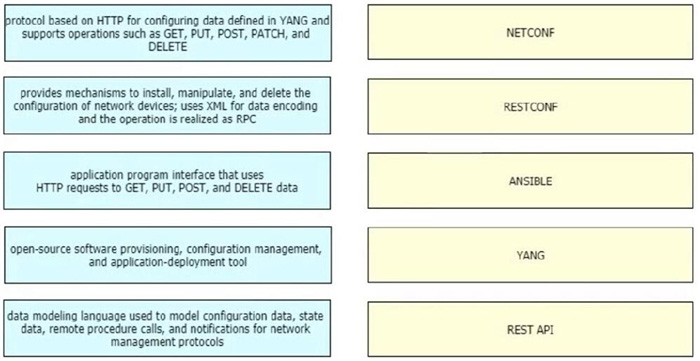
Correct Answer:
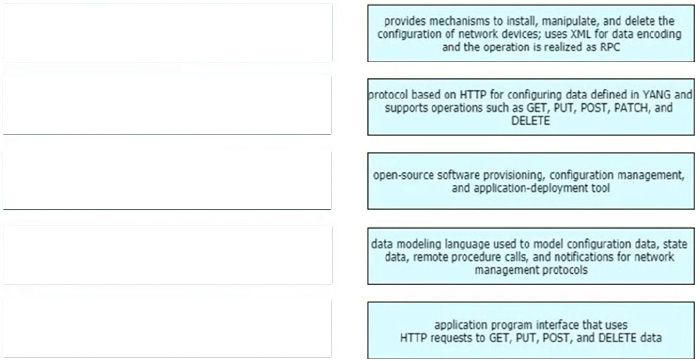
Question 7:
Which action must be taken before new VoIP systems are implemented on a network to ensure that the network is ready to handle the traffic?
A. Evaluate bandwidth utilization and connection quality
B. Enable special requirements such as direct DID lines on pickup
C. Make recommendations to limit the size of the half-open session table on routers
D. Check if anomaly detection is enabled for SIP and H.323 on Layer 3 devices
Correct Answer: A
Quality of the link is important for VoIP. You also need to ensure there is enough bandwidth.
Question 8:
Refer to the exhibit.
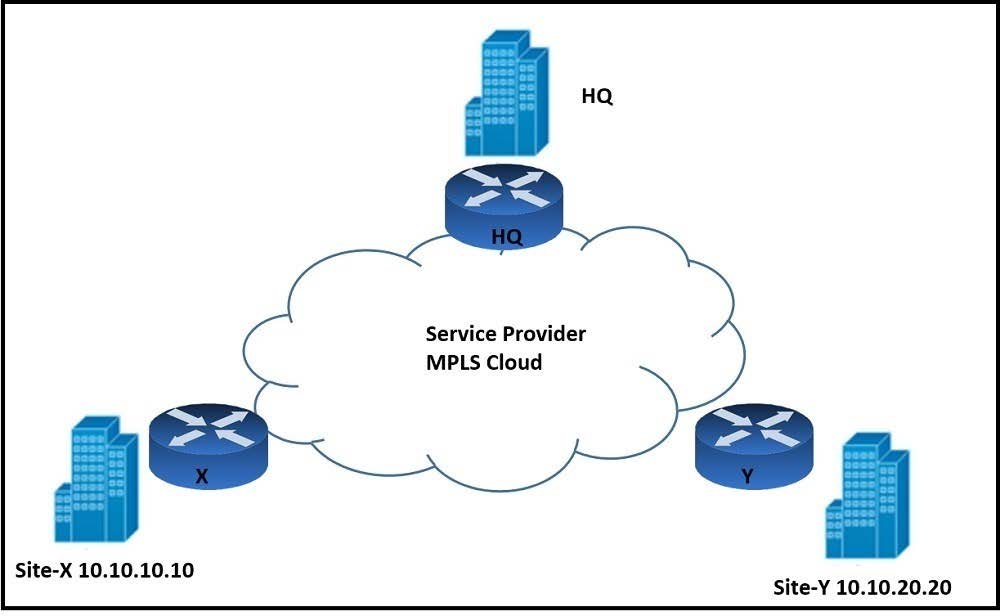
An architect must design an enterprise WAN that connects the headquarters with 22 branch offices. The number of remote sites is expected to triple in the next three years. The final solution must comply with these requirements:
Only the loopback address of each of the enterprise CE X and Y routers must be advertised to the interconnecting service provider cloud network.
The transport layer must carry the VPNv4 label and VPN payload over the MP- BGP control plane.
The transport layer must not be under service provider control.
Which enterprise WAN transport virtualization technique meets the requirements?
A. EIGRP Over the Top
B. MPLS over BGP over multipoint GRE
C. DMVPN per VRF
D. point-to-point GRE per VRF
Correct Answer: B
Question 9:
Which three tools are used for ongoing monitoring and maintenance of a voice and video environment? (Choose three.)
A. flow-based analysis to measure bandwidth mix of applications and their flows
B. call management analysis to identify network convergence-related failures
C. call management analysis to identify CAC failures and call quality issues
D. active monitoring via synthetic probes to measure loss, latency, and jitter
E. passive monitoring via synthetic probes to measure loss, latency, and jitter
F. flow-based analysis with PTP time-stamping to measure loss, latency, and jitter
Correct Answer: ACD
Question 10:
You have been tasked with designing a data center interconnect as part of business continuity You want to use FCoE over this DCI to support synchronous replication. Which two technologies allow for FCoE via lossless Ethernet or data center bridging? (Choose two.)
A. DWDM
B. EoMPLS
C. SONET/SDH
D. Multichassis EtherChannel over Pseudowire
E. VPLS
Correct Answer: AC
Question 11:
An architect receives a functional requirement for a NAC system from a customer security policy stating that if a corporate Wi-Fi device does not meet current AV definitions, then it cannot access the corporate network until the definitions are updated. Which component should be built into the NAC design?
A. posture assessment with remediation VLAN
B. quarantine SGTs
C. dACLs with SGTs
D. quarantine VLAN
Correct Answer: A
Question 12:
Company XYZ plans to run OSPF on a DMVPN network. They want to use spoke-to-spoke tunnels in the design.
What is a drawback or concern in this type of design?
A. Additional host routes will be inserted into the routing tables
B. Manual configuration of the spokes with the appropriate priority will be needed
C. There will be split-horizon issue at the hub
D. Manual configuration of the spoke IP address on the hub will be needed
Correct Answer: B
Question 13:
You are designing an Out of Band Cisco Network Admission Control. Layer 3 Real-IP Gateway deployment for a customer.
Which VLAN must be trunked back to the Clean Access Server from the access switch?
A. authentication VLAN
B. user VLAN
C. untrusted VLAN
D. management VLAN
Correct Answer: D
Question 14:
Refer to the exhibit.
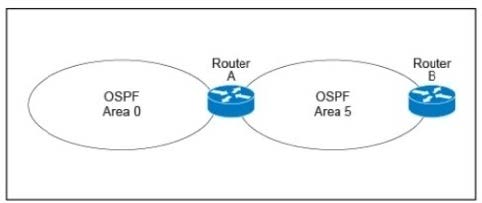
A customer runs OSPF with Area 5 between its aggregation router and an internal router When a network change occurs in the backbone. Area 5 starts having connectivity issues due to the SPF algorithm recalculating an abnormal number of times in Area 5 You are tasked to redesign this network to increase resiliency on the customer network with the caveat that Router B does not support the stub area.
How can you accomplish this task?
A. Increase the bandwidth on the connection between Router A and Router B
B. Implement LSA filtering ontheAB, allowing summary routes and preventing more specific routes into Area 5
C. Create a virtual link to Area 0 from Router B to the ABR
D. Turn on LSA throttling on all devices in Area 5
E. Set Area 5 to stubby at the ABR anyway
Correct Answer: B
Question 15:
Which effect of using ingress filtering to prevent spoofed addresses on a network design is true?
A. It reduces the effectiveness of DDoS attacks when associated with DSCP remarking to Scavenger.
B. It protects the network Infrastructure against spoofed DDoS attacks.
C. It Classifies bogon traffic and remarks it with DSCP bulk.
D. It filters RFC 1918 IP addresses.
Correct Answer: B
…
If you want an authentic test-like experience, Leads4Pass 400-007 practice questions: https://www.leads4pass.com/400-007.html
are a trusted option. They include real-world scenarios and are regularly updated based on Cisco’s latest question patterns.
Hands-On Practice Resources (Practical Learning)
To move from theory to design expertise:
- Cisco Learning Network: Official design case discussions & webinars.
- INE CCDE Bootcamp: Expert-led design analysis sessions with mock scenarios.
- Cisco Design Zone: Library of real-world architectures and configuration guides.
- Leads4Pass Practice Environment: Simulates exam-level design reasoning with updated 2025 question pools.
Career Benefits and Salary Insights (2025 Data)
CCDEs are among the world’s top 1% of network professionals — leading multi-domain design projects across cloud, enterprise, and service provider networks.
| Position | Average Annual Salary (USD) |
|---|---|
| Network Architect | $185,000 |
| Senior Design Engineer | $170,000 |
| Enterprise Infrastructure Consultant | $195,000 |
| Technical Director | $210,000 |
| Independent Design Expert | $150,000 – $260,000 |
Organizations value CCDEs for their ability to make high-impact design decisions that improve operational efficiency and long-term agility.
Frequently Asked Questions (FAQ)
Q1: Is the CCDE 400-007 exam difficult?
Yes, it’s one of Cisco’s most challenging certifications, testing conceptual mastery and design reasoning.
Q2: How long should I study for the CCDE?
Typically 3–6 months of dedicated preparation, depending on experience level.
Q3: Do I need to pass CCIE first?
No, CCIE is not required, though prior design experience helps significantly.
Q4: Can I take the written exam online?
Yes, the 400-007 written exam is available online through Pearson VUE.
Q5: What’s next after passing the written exam?
You qualify for the CCDE Practical Exam, where you’ll design end-to-end solutions in complex environments.
Conclusion: Design with Purpose, Lead with Vision
The Cisco 400-007 CCDE certification isn’t just another technical credential — it’s proof that you can design with clarity, communicate with impact, and lead with purpose.
Whether you’re working toward your first CCDE attempt or seeking to sharpen your design leadership, combining official resources with Leads4Pass 400-007 practice exam (https://www.leads4pass.com/400-007.html) gives you the best of both worlds — theory validated by practice.
Start now, refine your design mindset, and prepare to join the elite community of Cisco Certified Design Experts shaping tomorrow’s global networks.
![[SK0-005 Updated]Latest and effective CompTIA SK0-004 PDF questions and answers, expert recommendations to help you pass the exam](https://www.buklsainsa.org/wp-content/themes/instorm/img/thumb-medium.png)
